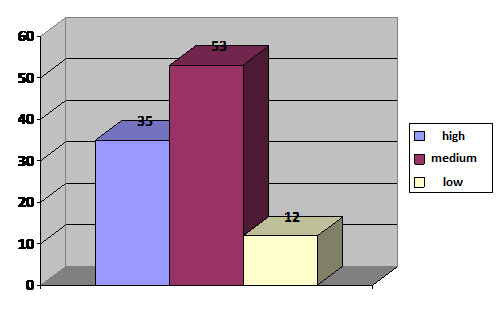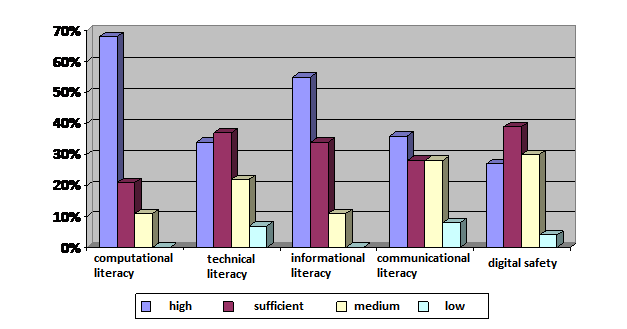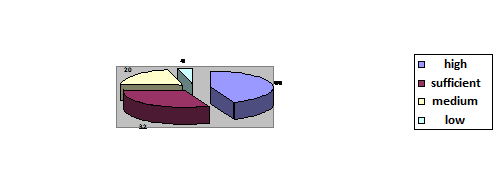Abstract
In modern educational system teachers are increasingly required who know their subject well, comprehend the specifics of using new methods and forms of education, master teaching techniques and understand their purpose. Important aspects of an effective educational process have become creativity, personal qualities, and abilities of a teacher. The ability to creatively rethink, transform the reality, find a variety of decisions for the same problem, use knowledge in a non-standard setting allows a personality to find a way out of any situation, as well as become successful, realize their potential under changing conditions of modern life. One more tendency has become a full or partial transition to digital educational resources. Today, on the Internet, there are a lot of educational portals and digital materials that require systematization and targeted use in the educational process. In this article, the authors reveal the role of digital educational resources in the formation of the personality of a creative teacher, as well as the role of creativity in the development and self-development of a teacher. Also, the authors give certain recommendations to create technologies of digital learning based on a creative approach.
Keywords: Creativity of teacher, digital learning, digital pedagogy, educational standards, media-formation
Introduction
At present, digital technologies are the trend increasingly involving areas of public life, and education is not an exception. Today, there is no doubt that a modern teacher must master digital technologies perfectly. Against the background of the pandemics that forced everyone to quickly switch to a remote learning format, many teachers began to use multimedia resources more often and mastered the basic technologies of working on the Internet. More than half of teachers plan to continue to actively use digital technologies after schoolchildren return to their desks (Boguslavsky, 2020).
More and more teachers realize the importance and usefulness of technologies for an educational process as they motivate and involve schoolchildren in self-educational activities, increase the attractiveness of learning and save time spent on looking for information (Young, 2016).
In education, the use of digital technologies ensures a strong competitive advantage. The teacher which does not limit teaching with chalkboards and textbook homework makes teaching more interesting and effective than their conservative colleagues do (Gjems & Sheridan, 2015).
Meanwhile, modern technologies are developing rapidly, and it is important not to miss anything, as well as create an individual innovative teaching style which will allow obtaining the highest results. This can be achieved only by a creative teacher who is constantly busy with self-development, alongside with the development and modernization of educational technologies (Khachaturova, 2018; Kuznetsov et al., 2018;).
Problem Statement
The pedagogy of creativity and the digitalization of learning have come in modern education almost simultaneously, on the edge of the 20th and 21st centuries. Despite the fact that in the last century non-standard approaches to teaching and upbringing of schoolchildren were welcomed too and yielded their fruits, the pedagogy of the 20th century was “locked” in the rather rigid framework of conservative “knowledge” paradigm which made teachers achieve clearly fixed results expressed in evaluation format. At the same time, even perfect possession of the entire set of necessary knowledge, skills and abilities did not guarantee graduates success in life, career, professional growth and development (Parpieva et al., 2020).
In this connection, modern education has shifted to the priority of the individual and the development of their potential, key personal competences, which go far beyond knowledge and skills. Motivation for active cognition, experimentation, search and processing of information in various, even non-standard, ways plays an important role in personal development of schoolchildren. The ability to solve problematic tasks and find way out in unpredictable changing conditions is the key to a personal success in the modern world. This puts forward new requirements for the personality of a teacher and technologies of educational and upbringing activities (Ivanchenko, 2020).
The digitalization of education is promising for the formation of a unique personality, the use of humanistic pedagogy, and individual, system-activity, competence-based approaches. It allows the teacher to experiment with teaching forms, methods of teaching and upbringing, educational platforms and other resources (Burns et al., 2020). However, any technology can be effective provided that it is implemented subsequently and systematically. Meanwhile today there are no uniform recommendations for organizing the creative educational process in a digital format, in order to maximize personal and professional goals of each teacher in a specific educational situation (Boronenko et al., 2018).
In addition, digital learning can be implemented using not only computers and tablets, but also mobile phones: using mobile devices helps to learn new material, and positively influences psychological and cultural aspects of students. Besides, teachers should support digital culture of students, involving resources of digital materials and the smartphone use in school activities (Sari et al., 2020).
Research Questions
The research answers the following questions:
3.1. What is the essence of digital learning?
3.2. What prospects does the digitalization of learning have in the modern world?
3.3. What is pedagogical technology and pedagogical creativity?
3.4. What are the prospects for digital pedagogy as a technology for the development of pedagogical creativity?
Purpose of the Study
Highlighting the main aspects of using the provisions of digital pedagogy in creating a technology for the development of pedagogical creativity.
Research Methods
The following research methods were used: theoretical review of literary sources on the topic (analysis, synthesis, generalization); empirical research (testing, questioning), methods of mathematical statistics.
Our study analyzed the use of the principles of digital pedagogy in the development of pedagogical creativity. For this purpose, an experiment was organized, which included:
- diagnostics of the creative potential of teachers;
- diagnostics of the level of digital literacy of teachers;
- recommendations for the development of pedagogical creativity using digital technologies.
As research methods were chosen:
- methods for diagnosing creative activities of teachers (Rakitskaya, & Kashapov, 2001),
- DIGLIT tool for evaluating digital literacy of teachers,
3. correlation analysis according to Spearman.
Findings
Based on the data obtained, it can be concluded that digital pedagogy is being actively introduced into the practice of teachers in modern schools (Figure 1).

As can be seen from the diagnostic results, 35% of the teachers have a high creative potential (40 or more points). This quality provides a rich choice of creative possibilities and the freedom to move from one educational technology to another. Such teachers easily accept any innovations, “keep their finger on the pulse” of new trends in the development of world pedagogical science and practice, and actively adopt advanced pedagogical experience. If they can fully realize their abilities in practice, then they will have access to the most diverse forms of creativity.
Most of the teachers (53%) showed a medium level of creative development (20-40 points). In other words, they have qualities that allow them to create, but there are also barriers to the implementation of the pedagogy of creativity. The most dangerous of these is the fear of failure, which constrains the imagination and hinders the free expression of creativity in the profession. It can also be social fear of public condemnation. Any new idea goes through a stage of non-recognition, caution, skepticism, condemnation by others. Fear of condemnation for unusual behavior, views, feelings, actions, approaches, beliefs restricts creative activity, destroys the creative personality of a teacher.
At the same time, 12% of teachers tend to adhere to the conservative technologies of traditional pedagogy. They are not creative in teaching, because they believe that adherence to established norms and criteria is the key to effective education. Their activities, as a rule, are quite regulated, but they are not perceived by modern generations of students as motivating.
Analysis of the indicators of the main components of digital literacy of teachers showed that about half of teachers had a high level of mastering modern digital technologies (Figure 2)

Summary of the test results showed that the high level of digital literacy including all the indicators was noted in 44% of the teachers who mastered software freely since they could create programs independently. These teachers can easily use various digital resources at class and in out-of-class activities, since they have the skills of processing, systematizing and analyzing digital data, compiling databases, using graphic editors, and so on. The wide range of digital technologies allows them to make lessons diverse, rich and interesting. Moreover, it is the creative abilities of a teacher that allow them to select and create a special cognitive environment at class.
32 % of the teachers showed a sufficient level of proficiency in digital educational technologies. Their digital literacy manifests itself with their proficiency in standard programs, the presence of a blog or site at which a structured work is carried out, materials are posted, learners and their parents are communicated with, and so on.
Meanwhile, 20% of the teachers showed a medium level of digital literacy which indicates the presence of certain difficulties with the formation of their pedagogical technology based on digital resources. Since they do not freely possess all multimedia possibilities, sometimes they cannot creatively use these resources at class and in out-of-class activities.
4% of the teachers do not use digital resources at all, or they ask other specialists to help them with the online teaching (Figure 3).

The correlation analysis showed that there was a close correlation(rs = 0.736) between the creative self-realization of teachers and the level of proficiency in digital pedagogy principles, with a significance level of р = 0.01 r crit = 0.57. So, the correlation between the signs is significant.
This means that the teacher which actively uses digital aids and multimedia technologies in teaching, organizes educational and self-educational activities of learners on various online platforms, constantly introduces ICT innovations into their practice is a creative educator focused on constant transformations in their work. In turn, the development of pedagogical creativity facilitates the development of creativity, thinking and cognition of schoolchildren, finally, the achievement of high educational results (Petrishchev, 2021).
Based on these results, we concluded that in their practice teachers should constantly and systematically develop, design and creatively introduce modern digital technologies into teaching and self-education. At the same time, it is important also to demonstrate own experience and creative results.
Diverse remote competitions, webinars, master-classes and other online forms of work have a great potential for the development of pedagogical creativity. After the publication of the author's material, as a rule, a discussion is organized on the forum, advice is given how to improve the work, thanks to which it becomes possible to improve the resource. Each material is studied by several independent experts drawing their conclusion. All expert tables with the evaluation criteria are sent to the author who can analyze their work (Kullaslahti et al., 2019).
In the learning process, virtual laboratories, creative workshops, quests, online travels, etc. are widely used. Such forms are based on the values of open education: educational mobility, cultural competence, individual history, which is the answer to the challenges of our time (Skulkin, 2021). During the interactive communication, participants can perform various tasks: compose articles, create e-presentations, videos, photos, drawings, crafts, which they present to experts. Such a work allows them to know new things about the surrounding world, their region and country, to learn how to creatively collaborate and to accumulate an important social experience (Gorelova & Khilko, 2020).
The teacher and student of the 21st century are companions and partners walking alongside with one and the same goal: knowledge of the world and the development of the country and society in accordance with the requirements and trends of the time. These requirements include a creative approach, and the continuous development of pedagogical proficiency, in order to form a harmonious competent personality of the learner (Kyshtymova, 2020).
Conclusion
Today, the digital pedagogy acts as a powerful resource and provides ample opportunities for the professional and creative growth of a teacher. However, these tools can only help the teacher. If we want schoolchildren to have a desire to act independently and immerse themselves in the topic, then expert knowledge and charisma of the teacher may not be enough.
Modern children are not able to concentrate on anything for a long time, they practically do not use paper sources, since they have the Internet from birth. In this sense, it is important for the teacher to be on the same level with them, to speak the same language, to communicate using those means that are natural for new generations of children. A person who does not know what digital technologies and Internet resources, educational platforms and media space are, will not be able to effectively meet the demands of society.
The system-activity approach is the most suitable for the implementation of these conditions, since it allows teachers and administrators to introduce various design and research activities into wide pedagogical practice (Raymond et al., 2016).
It is easy to see how the function of transferring knowledge is gradually giving way to the function of designing, which consists in following the student’s thought, creating their educational environment and teaching them to acquire knowledge without outside help. The teacher's activity is becoming more and more diverse, combining a wide range of forms, methods, techniques. This encourages the teacher to constantly improve their analytical, diagnostic and design skills, which allow them to build a more effective educational process, quickly adjusting the development of students.
If the teacher is well versed in the Internet, it inspires respect and trust among their students. This is very important not only from the point of view of the effectiveness of teaching, but also from the point of view of the authority of the teacher, their creative development and realization, their uniqueness, which will only increase with the wider use of digital technologies.
References
Boguslavsky, M. V. (2020). Realizatsiya potentsiala gumanisticheskoy pedagogiki v kontekste obrazovatel’noy real’nosti tsifrovoy epokhi [Realizing the potential of humanistic pedagogy in the context of the educational reality of the digital age]. Gumanitarnyye issledovaniya Tsentral’noy Rossii [Humanitarian Studies of Central Russia], 4(17), 46-53. DOI:
Boronenko, T. A., Kaysina, A. V., & Fedotova, V. S. (2018). Otsenka mediakul’tury uchitelya kak komponenta ego kvalifikatsionnogo portreta [Assessment of the teacher's media culture as a component of their qualification portrait]. Obrazovaniye i nauka [The Education and Science Journal], 4, 34-40. DOI:
Burns, E., Silvennoinen, E., Kopnov, V. A., Shchipanova, D. E., Papić-Blagojević, N., & Tomašević, S. (2020). Supporting the development of digitally competent vet teachers in Serbia and Russia. Obrazovaniye i nauka [The Education and Science Journal], 22(9), 176-182.
Gjems, L., & Sheridan, S. (2015). Early literacy in Norwegian and Swedish preschool teacher education. Psychology in Russia, 2, 4-11. DOI:
Gorelova, J., & Khilko, N. (2020). Organizational forms of implementation of pedagogical technologies in the media education system. International Journal of Media and Information Literacy, 5(1), 31-36. DOI:
Ivanchenko, D. A. (2020). K voprosu formirovaniya i otsenki tsifrovoy gramotnosti lichnosti [On the formation and assessment of digital literacy of an individual]. Problemy sovremennogo obrazovaniya [Problems of Modern Education], 3, 66-73. DOI:
Khachaturova, K. R. (2018). Theoretical grounds of teaching in adolescence. Components of Scientific and Technological Progress, 2(36), 29-31.
Kullaslahti, J., Ruhalahti, S., & Brauer, S. (2019). Professional development of digital competences: standardized frameworks supporting evolving digital badging practices. Journal of Siberian Federal University. Humanities & Social Sciences, 12, 175-186. DOI:
Kuznetsov, N., Vovchenko, N., Samoilov, A., & Bykasova, L. (2018). Reflection modulations in the media. Media Education, 1, 31-39.
Kyshtymova, E. (2020). Psychological media competence of advertising specialists and educational psychologists. Media Education, 2020, 60(4), 688-701. DOI: 10.13187/me.2020.4.688
Parpieva, N., Yakubova, U., & Mirkhodjaeva, N. (2020). The relevance of integration of modern digital technologies in teaching mathematics. Bulletin of Science and Practice, 6(4), 438-456. DOI: 10.33619/2414-2948/53/51
Petrishchev, I. O. (2021). Obucheniye na osnove sredstv tsifrovoy pedagogiki kak faktor povysheniya kachestva obrazovatel’nykh uslug i modernizatsii obrazovaniya [Learning based on digital pedagogy as a factor in improving the quality of educational services and modernizing education]. Vestnik Chuvashskogo gosudarstvennogo pedagogicheskogo universiteta im. I. Ya. Yakovleva [Bulletin of the I. Yakovlev Chuvash State Pedagogical University], 1(110), 183-190. DOI:
Rakitskaya, O. N., & Kashapov, M. M. (2001). Metodika na opredeleniye tvorcheskoy aktivnosti lichnosti uchitelya [Methodology for determining the creative activity of the teacher's personality]. Vash Psikholog [Your Psychologist]. http://www.vashpsixolog.ru/psychodiagnostic-school-psychologist/113-diagnosis-pedkollektiva/ 2696- metodika-na-opredelenie-tvorcheskoj-aktivnosti-lichnosti-uchitelya
Raymond, A., Jacob, E., Jacob, D., & Lyons, J. (2016). Peer learning a pedagogical approach to enhance online learning: a qualitative exploration. Nurse Education Today, 44, 165-169. DOI: 10.1016/j.nedt.2016.05.016
Sari, A. I., Suryani, N., Rochsantiningsih, D., & Suharno, S. (2020). Digital learning, smartphone usage, and digital culture in Indonesia Education. Indonesia education. Integratsiya obrazovaniya [Integration of Education], 24(1), 20-31. DOI:
Skulkin, A. A. (2021). Formirovaniye tsifrovogo obrazovatel’nogo prostranstva: adaptatsiya tsifrovoy pedagogiki [Formation of a digital educational space: adaptation of digital pedagogy]. Mir nauki, kul’tury, obrazovaniya [The World of Science, Culture, Education], 1(86), 277-280. https://doi.org/
Young, S. (2016). From disruption to innovation: thoughts on the future of MOOCs. Azerbaijan Journal of Educational Studies, 17(4), 21-43. DOI:
Copyright information

This work is licensed under a Creative Commons Attribution-NonCommercial-NoDerivatives 4.0 International License.
About this article
Publication Date
28 December 2021
Article Doi
eBook ISBN
978-1-80296-119-5
Publisher
European Publisher
Volume
120
Print ISBN (optional)
-
Edition Number
1st Edition
Pages
1-877
Subjects
Culture, communication, history, mediasphere, education, law
Cite this article as:
Donina, I. A., & Khachaturova, K. R. (2021). Creativity Of Teacher In Conditions Of Digital Transformation Of Education. In D. Y. Krapchunov, S. A. Malenko, V. O. Shipulin, E. F. Zhukova, A. G. Nekita, & O. A. Fikhtner (Eds.), Perishable And Eternal: Mythologies and Social Technologies of Digital Civilization, vol 120. European Proceedings of Social and Behavioural Sciences (pp. 824-831). European Publisher. https://doi.org/10.15405/epsbs.2021.12.03.109

